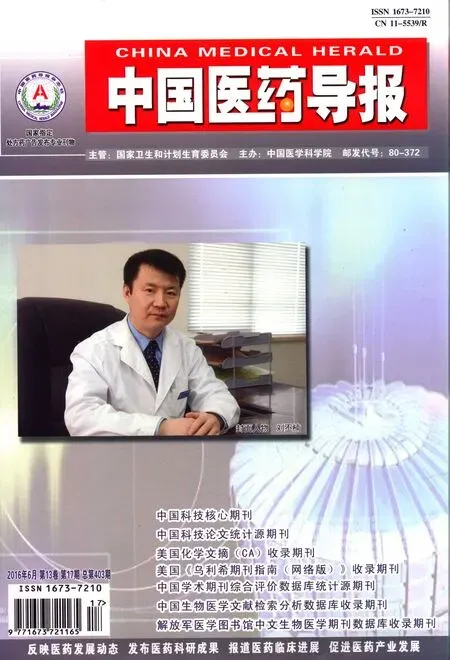维持性血液透析患者甲状腺激素水平情况分析
袁志娟 程志强
1.河北北方学院附属第三医院肾内科,河北张家口075000;2.河北北方学院附属第三医院内分泌科,河北张家口075000
维持性血液透析患者甲状腺激素水平情况分析
袁志娟1程志强2
1.河北北方学院附属第三医院肾内科,河北张家口075000;2.河北北方学院附属第三医院内分泌科,河北张家口075000
目的研究维持性血液透析(HD)患者的甲状腺激素水平情况。方法选取2014年8月~2015年8月在河北北方学院附属第三医院维持性血液透析的患者40名为HD组,同期选择40例健康者为对照组。利用电化学发光免疫检测仪测定总三碘甲状腺原氨酸(TT3)、游离三碘甲状腺原氨酸(FT3)、总甲状腺素(TT4)、游离甲状腺素(FT4)、促甲状腺素(TSH),比较HD患者与健康人群的甲状腺功能,以及不同透析时间HD患者的甲状腺功能。结果①HD组TT3水平显著低于对照组,差异有统计学意义(P<0.05);TT4水平显著低于对照组,差异有统计学意义(P<0.05);TSH显著高于对照组,差异有统计学意义(P<0.05)。②HD组与对照组比较,低T3综合征及亚临床甲状腺功能减退症发生率均明显高于对照组,差异有统计学意义(P<0.05)。③在血液透析患者中,透析时间≤72个月的患者低T3综合征发生率高于透析时间>72个月的患者,差异有统计学意义(P<0.05)。而透析时间>72个月患者的亚临床甲状腺功能减退症发生率高于透析时间≤72个月的患者,差异有统计学意义(P<0.05)。结论血液透析患者甲状腺功能异常较一般人群高,因此甲状腺功能的筛查是有必要的。
维持性血液透析;甲状腺激素;甲状腺功能减退;低T3综合征
慢性肾脏病(CKD)影响下丘脑-垂体-甲状腺轴。终末期肾脏病(ESRD)患者垂体分泌促甲状腺激素(TSH)紊乱,并且TSH反应性地使下丘脑分泌促甲状腺激素释放激素(TRH)减少[1-3]。CKD通过降低循环中的甲状腺激素水平来影响甲状腺功能,干扰激素与蛋白质载体的结合,干扰甲状腺激素的代谢和消除[2],影响甲状腺碘的储存[1,4]。CKD患者血清碘浓度高,是由于肾小球滤过率降低使碘清除率减少所致。CKD患者血清碘浓度升高可能会阻断甲状腺激素的合成(Wolf-Chaikoff效应),这可能是导致CKD患者甲状腺功能减退症的发病率较高的原因[5]。更特别的是,随着肾小球滤过率(GFR)降低,甲状腺功能减退症的患病率增加,尤其是亚临床甲状腺功能减退症[6-7]。维持性血液透析(HD)可以使甲状腺激素浓度异常,主要是减少总T3和游离T3的浓度[2]。有些HD患者血清总T4(TT4)和游离T4(FT4)高,这可能是由于HD患者在血液透析中使用肝素抗凝(lipolitic效应)[8]影响TT4、FT4的浓度。本研究的目的是研究血液透析患者甲状腺激素水平,比较HD析患者和健康人的甲状腺功能,并评估透析时间和甲状腺疾病之间是否有联系。
1 资料与方法
1.1一般资料
选取2014年8月~2015年8月河北北方学院附属第三医院HD的患者40例为HD组,HD患者每周透析2~3次,每次4 h,透析时间平均(60.32±36.18)个月。另选择40例健康者为对照组。所有患者均排除无近期感染、心力衰竭、急性心肌梗死、急性脑血管疾病、肿瘤、系统性疾病;所有患者均既往无甲状腺疾病病史,未口服影响甲状腺功能的药物。两组在年龄、性别、体重指数一般资料比较,差异无统计学意义(P>0.05)。见表1。
表1 HD组与对照组一般资料比较(±s)

表1 HD组与对照组一般资料比较(±s)
组别例数年龄(岁)体重指数(k g / m2)性别(例)女性男性H D组对照组P值4 0 4 0 5 3 . 2 8 ± 1 1 . 7 6 4 9 . 4 3 ± 7 . 8 0>0 . 0 5 2 2(5 5 ) 2 0(5 0 )>0 . 0 5 1 8(4 5 ) 2 0(5 0 )>0 . 0 5 2 3 . 1 5 ± 2 . 0 7 2 5 . 1 3 ± 2 . 2 9>0 . 0 5
40例HD患者中透析时间≤72个月26例,透析时间>72个月患者14例。两组年龄、性别、体重指数、肾小球滤过率一般资料比较,差异无统计学意义(P>0.05)。见表2。
1.2方法
血液透析患者使用费森尤斯4008 s血液透析机,费森尤斯聚砜血液透析器FX60/FX80高通量膜。标准碳酸氢盐透析血液透析治疗。
1.3观察指标
总三碘甲状腺原氨酸(TT3)、三碘甲状腺原氨酸(FT3)、总甲状腺素(TT4)、游离甲状腺素(FT4)、促甲状腺素(TSH)。所有受检对象禁食10 h清晨空腹采上肢静脉血,透析患者透析前采血。罗氏COBAS e601型全自动电化学发光免疫检测仪利用电化学发光法测定甲状腺激素水平。
1.4评价标准
1.4.1甲状腺激素水平正常参考值TT3(正常值1.20~3.40 nmol/L),FT3(正常值3.10~6.80 pmol/L),TT4(正常值66.00~181.00nmol/L),FT4(正常值12.00~22.00pmol/L), TSH(正常值0.27~4.22 μU/mL)。
1.4.2各种甲状腺功能异常诊断标准亚临床甲状腺功能减退症:仅有血清促甲状腺激素(TSH)水平轻度升高>4 μU/mL,而血清甲状腺激素(FT4、FT3)水平正常,患者无甲减症状或仅有轻微甲减症状,称为亚临床甲状腺功能减退症(subclinical hypothyroidism,简称“亚临床甲减”)[9]。甲状腺功能减退症(hypothyroidism,简称“甲减”):TSH升高>10 μU/mL和血清T3、T4降低[10]。低T3综合征指为血清TT3、FT3水平下降,TSH正常[11]。甲状腺功能亢进症(hyperthyroidism,简称“甲亢”):血清T3、T4升高,和TSH降低。亚临床甲状腺功能亢进(subclinical hyperthyroidism,简称“亚临床甲亢”):仅有血清促甲状腺激素(TSH)水平降低,而血清甲状腺激素(FT4、FT3)水平正常,患者无甲亢症状或仅有轻微甲亢症状。
表2 HD组不同透析时间的患者一般资料比较(±s)

表2 HD组不同透析时间的患者一般资料比较(±s)
透析时间例数年龄(岁)体重指数(k g / m2)性别(例)女性男性肾小球滤过率[ m L /(m i n · 1 . 7 3 m2) ]透析时间≤7 2个月透析时间>7 2个月P值2 6 1 4 5 4 . 3 5 ± 1 2 . 5 8 5 1 . 2 9 ± 1 0 . 1 9>0 . 0 5 1 5(5 7 . 7 ) 7(5 0 )>0 . 0 5 1 1(4 2 . 3 ) 7(5 0 )>0 . 0 5 2 2 . 9 6 ± 1 . 9 5 2 3 . 5 ± 2 . 3 1>0 . 0 5 1 2 . 3 5 ± 2 . 0 8 1 2 . 3 6 ± 1 . 8 7>0 . 0 5
1.5统计学方法
采用统计软件SPSS 19.0对数据进行分析,正态分布的计量资料以均数±标准差(±s)表示,两组间比较采用t检验;计数资料以率表示,采用χ2检验。相关性分析采用Spearman分析以P<0.05为差异有统计学意义。
2 结果
2.1HD组与对照组甲状腺功能情况
HD组TT3平均水平显著低于对照组,差异有统计学意义(P<0.05);TT4平均水平显著低于对照组,差异有统计学意义(P<0.05);TSH平均值显著高于对照组,差异有统计学意义(P<0.05)。见表3。
表3 HD组与对照组甲状腺功能情况比较(±s)

表3 HD组与对照组甲状腺功能情况比较(±s)
注:TT3总三碘甲状腺原氨酸;FT3三碘甲状腺原氨酸;TT4总甲状腺素;FT4游离甲状腺素;TSH促甲状腺素
组别例数TT3(nmol/L) TT4(nmol/L) FT3(pmol/L) FT4(pmol/L) TSH(μU/mL) HD组对照组P值40 40 1.36±0.45 2.24±0.47<0.05 80.33±19.17 102.66±28.84<0.05 5.21±2.01 5.41±1.41>0.05 14.19±3.47 15.13±4.06>0.05 3.16±3.17 1.83±0.94<0.05
2.2HD组与对照组甲状腺功能异常的发生情况比较
HD组与对照组比较,低T3综合征发生率明显高于对照组,差异有统计学意义(P<0.05);亚临床甲状腺功能减退症发生率明显高于对照组,差异有统计学意义(P<0.05),高T4、低T4、甲减、亚临床甲亢的发生率与对照组比较,差异无统计学意义(P>0.05)。见表4。
2.3不同透析时间的患者甲状腺功能异常的发生情况比较
在血液透析患者中,透析时间≤72个月的患者低T3综合征发生率高于透析时间>72个月的患者,差异有统计学意义(P<0.05)。而透析时间>72个月患者的亚临床甲减发生率高于透析时间≤72个月的患者,差异有统计学意义(P<0.05);而不同透析时间的患者低T4、甲减、亚临床甲亢的发生率差异无统计学意义(P>0.05)。见表5。

表4 HD组与对照组甲状腺功能异常的发生情况比较[n(%)]

表5 不同透析时间的患者甲状腺功能异常的发生情况比较[n(%)]
3 讨论
Lim等[12]报道HD患者低T3的发生率为40%。本研究结果显示,HD患者甲状腺功能紊乱发生率明显高于健康人。Song等[13]研究随着eGFR的下降,低T3的发生率逐渐增加,当eGFR<15 mL/min/1.73 m2时,低T3综合征的发生率高达78.6%,这项回顾性研究2284例CKD患者,观察慢性肾脏病的不同阶段患者低T3的发生率以及GFR与血清FT3水平的关系,研究发现当肾脏功能受损逐渐发生慢性肾功能衰竭时,因为内环境的改变,激素水平常发生变化,进而导致低T3的发生。而且在肾功能异常的不同时期,低T3发生率由高到低依次为:慢性肾功能衰竭(尿毒症期)>慢性肾功能衰竭(肾衰竭期)>慢性肾功能衰竭(失代偿期)>慢性肾功能衰竭(代偿期)>正常对照组;GFR与血清FT3水平两者呈有正相关[13-14]。本研究中显示HD患者血清T3平均值显著低于健康人(P<0.05),HD患者低T3综合征的发生率明显高于健康人(P<0.05),发现与相关文献报道[13-18]相似。研究报道[15]HD患者最常见的甲状腺失调是低T3综合征,在此研究中表明低T3与终末期肾脏病患者的炎症、心血管损害有关。低T3综合征是心血管血管疾病的独立危险因素[16]。这些研究结果表明,低T3、低FT3可能是反映终末期CKD患者预后的标志物。Rotondi等[17]发现肾移植前低血清T3水平和肾移植生存率降低有关。
肾脏对甲状腺内分泌功能有重要影响,CKD患者甲状腺功能异常的病因是多因素的,它并没有被完全阐明。慢性肾功能衰竭(CRF)患者由于肾脏功能受损,可导致甲状腺功能障碍,致使多种甲状腺激素(TH)合成、分泌发生异常改变,其发生机制目前尚未完全明确,大多数学者认为这主要是机体的一种代偿性改变,其目的主要是减少慢性病过程中存在的高分解代谢[18]。考虑到甲状腺功能减退症的临床特点常被尿毒症状态所掩盖,对所有HD患者进行甲状腺功能检查是必要的。
综上所述,与健康人比较,HD患者甲状腺异常更为常见,并且与患者的透析时间有关。多项临床证据表明HD患者出现甲状腺功能异常,与其发生心血管疾病(CVD)及CVD高死亡率密切相关[19-25]。因此临床上有必要对于维持性HD患者监测其TH水平。
[1]Lim VS.Thyroid function in patients with chronic renal failure[J].Am J Kidney Dis,2001,38(4 Suppl 1):S80-S84.
[2]Iglesias P,Díez JJ.Thyroid dysfunction and kidney disease[J].Eur J Endocrinol,2009,160(4):503-515.
[3]Singh PA,Bobby Z,Selvaraj N,et al.An evaluation of thyroid hormone status and oxidative stress in undialyzed chronic renal failure patients[J].Indian J Physiol Pharmacol,2006,50(3):279-284.
[4]Kaptein EM.Thyroid hormone metabolism and thyroid diseases in chronic renal failure[J].Endocr Rev,1996,17(1): 45-63.
[5]Brough R,Jones C.Iatrogenic iodine as a cause of hypothyroidism in infants with end-stage renal failure[J]. Pediatr Nephrol,2006,21(3):400-402.
[6]Lo JC,Chertow GM,Go AS,et al.Increased prevalence of subclinical and clinical hypothyroidism in persons with chronic kidney disease[J].Kidney Int,2005,67(3):1047-1052.
[7]Chonchol M,Lippi G,Salvagno G,et al.Prevalence of subclinical hypothyroidism in patients with chronic kidney disease[J].Clin J Am Soc Nephrol,2008,3(5):1296-1300.
[8]Bayer MF.Effect of heparin on serum free thyroxine linked to post-heparin lipolytic activity[J].Clin Endocrinol(Oxf),198,19(5):591-596.
[9]Canaris GJ,Manowitz NR,Mayor G,et al.The Colorado thyroid disease prevalence study[J].Arch Intern Med,2000. 160(4):526-34.
[10]李利英,曲丽.高通量血液透析对尿毒症继发性甲状旁腺功能亢进患者的甲状旁腺素和钙磷代谢的影响[J].临床和实验医学杂志,2015,15(20):1716-1719.
[11]Witzke O,Wiemann J,Patschan D,et al.Differential T4 degradation pathways in young patients with preterminal and terminal renal failure[J].Horm Metab Res,2007,39(5):355-258.
[12]Lim VS,Fang VS,Katz AI,et al.Thyroid dysfunction in chronic renal failure.A study of the pituitary-thyroid axis and peripheral turnover kinetics of thyroxine and triiodothyronine[J].J Clin Invest,1977,60(3):522-534.
[13]Song SH,Kwak IS,Lee DW,et al.The prevalence of low triiodothyronine according to the stage of chronic kidney disease in subjects with a normal thyroid-stimulating hormone[J].Nephrol Dial Transplant,2009,24(5):1534-1538.
[14]Thysen B,Gatz M,Freeman R,et al.Serum thyroid hormone levels in patients on continuous ambulatory peritoneal dialysis and regular hemodialysis[J].Nephron., 1983,33(1):49-52.
[15]Zoccali C,Tripepi G,Cutrupi S,et al.Low triiodothyronine:a new facet of inflammation in end-stage renal disease[J].J Am Soc Nephrol,2005,16(9):2789-2795.
[16]Tatar E,Kircelli F,Asci G,et al.Associations of triiodothyronine levels with carotid atherosclerosis and arterial stiffnessinhemodialysispatients[J].ClinJAmSocNephrol, 2011,6(9):2240-2246.
[17]Rotondi M,Netti GS,Rosati A,et al.Pretransplant serum FT3 levels in kidney graft recipients are useful for identifying patients with higher risk for graft failure[J].Clin Endocrinol(Oxf),2008,68(2):220-225.
[18]Enia G,Panuccio V,Cutrupi S,et al.Subclinical hypothyroidism is linked to micro-inflammation and predicts death in continuous ambulatory peritoneal dialysis[J]. Nephrol Dial Transplant,2007,22(2):538-544.
[19]Papaioannou GI,Lagasse M,Mather JF,et al.Treating hypothyroidism improves endothelial function[J].Metabolism,2004,53(3):278-279.
[20]Napoli R,Guardasole V,Zarra E,et al.Impaired endothelial-and nonendothelial-mediated vasodilation in patients with acute or chronic hypothyroidism[J].Clin Endocrinol(Oxf),2010,72(1):107-111.
[21]Shoji T,Maekawa K,Emoto M,et al.Arterial stiffness predicts cardiovascular death independent of arterial thickness in a cohort of hemodialysis patients[J].Atherosclerosis,2010,210(1):145-149.
[22]Nagasaki T,Inaba M,Shirakawa K,et al.Increased levels of C-reactive protein in hypothyroid patients and its correlation with arterial stiffness in the common carotid artery[J].Biomed Pharmacother,2007,61(2-3):167-172.
[23]Lin YC,Lin YC,Chen TW,et al.Abnormal thyroid function predicts mortality in patients receiving longterm peritoneal dialysis:a case-controlled longitudinal study [J].J Chin Med Assoc,2012,75(2):54-59.
[24]袁志娟,程志强.非糖尿病维持性血液透析患者甲状腺水平情况及其与颈动脉硬化的相关性分析[J].中国医药导报,2016,13(4):56-59.
[25]Meuwese CL,Dekker FW,Lindholm B,et al.Baseline levels and trimestral variation of triiodothyronine and thyroxine and their association with mortality in maintenance hemodialysis patients[J].Clin J Am Soc Nephrol, 2012,7(1):131-138.
Analysis of thyroid hormone level in patients with maintenance hemodialysis
YUAN Zhijuan1CHENG Zhiqiang2
1.Department of Nephrology,the Third Affiliated Hospital of Hebei North University,Hebei Province,Zhangjiakou 075000,China;2.Department of Endocrinology,the Third Affiliated Hospital of Hebei North University,Hebei Province,Zhangjiakou075000,China
Objective To investigate the thyroid hormone level in patients with maintenance hemodialysis(HD).Methods Forty patients with maintenance hemodialysis(HD)in the Third Affiliated Hospital of Hebei North University from August 2014 to August 2015 were selected as HD group,at the same time 40 healthy persons were selected as control group.The electrochemical luminescence immune detector was used to determine total tri-iodothyronine(TT3),free triiodothyronine(FT3),total thyroxine(TT4),free thyroxine(FT4),thyroid-stimulating hormone(TSH).The thyroid function of HD patients and healthy people was compared,and thyroid function of patients with different hemodialysis time was compared.Results①TT3in the HD group was significantly lower than that in control group,the difference was statistically significant(P<0.05);TT4in the HD group was significantly lower than that in control group,the difference was statistically significant(P<0.05);TSH in the HD group was significantly higher than that in control group,the difference was statistically significant(P<0.05).②Compared with control group,the incidence of low T3syndrome and of subclinical hypothyroidism in the HD group were significantly higher,the difference was statistically significant(P<0.05).③Among HD patients,the incidence of low T3syndrome in patients with hemodialysis time≤72 months was higher than that in patients with hemodialysis time>72 months,the difference was statistically significant(P<0.05); subclinical hypothyroidism in patients with hemodialysis time>72 months was higher than that in patients with hemodialysis time≤72 months,the difference was statistically significant(P<0.05).Conclusion Patients with hemodialysis have higher incidence of thyroid dysfunction than general persons,therefore thyroid function screening is necessary.
Hemodialysis;Thyroid hormone;Hypothyroidism;Low T3syndrome
R459.5
A
1673-7210(2016)06(b)-0121-04
(2016-03-06本文编辑:苏畅)

